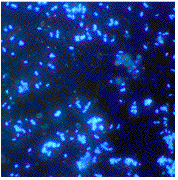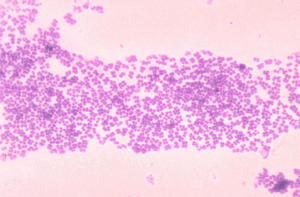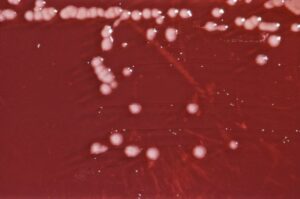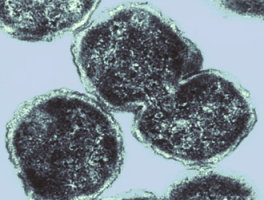These are microorganisms that convert nitrates in the soil to nitrogen gas in the atmosphere .There is a detailed description of denitrifying bacteria examples provided.
The conversion of nitrate and nitrite to nitrous oxide and dinitrogen gas is known as denitrification . Many Bacteria and Archaea have the ability to denitrify , and a variety of organic and inorganic substances can be employed as electron donors.
- Thiobacillus denitrificans
- Micrococcus denitrificans
- Pseudomonas denitrificans
- Alcaligenes faecalis
- Streptomycetes
- Paracoccus denitrificans
- Thiosphaera pantotropha
- Prolixibacter denitrificans
- Zobellella denitrificans
- Steroidobacter denitrificans
- Ferrovibrio denitrificans
- Halobacterium denitrificans
- Thiomicrospira denitrificans
- Pseudomonas aeruginosa
- Noviherbaspirillum denitrificans
- Rhodanobacter denitrificans
- Blastobacter denitrificans
- Bradyrhizobium denitrificans
- Kingella denitrificans
- Jonesia denitrificans
- Achromobacter denitrificans
Thiobacillus denitrificans
1. Thiobacillus denitrificansis a facultative anaerobe bacterium that is obligately chemolithoautotrophic. It is best known for its capacity to link inorganic sulphur compound oxidation to denitrification. Image credited by Wikipedia It’s a natural agent for nitrate-polluted groundwater intrisic bioremediation.

It’s also been used to remove nitrates in designed water treatment systems. Its ability to perform nitrate-dependent Fe(II) oxidation under anaerobic conditions could have an impact on metal and radionuclide transport in the subsurface, as ferric iron-containing minerals, particularly iron(III) oxides, are well-known for their ability to adsorb heavy metals and radionuclides like uranium.
Micrococcus denitrificans
Micrococcus denitrificans can do both assimilatory and dissimilatory nitrate reduction, but only the assimilatory mechanism works in both aerobic and anaerobic environments. Aeration has at least three effects on a growing culture’s dissimilatory activity (the conversion of nitrate to nitrogen): 1)It prevents the adaptive development of the system; 2) If the system is already existing, it partially represses any further synthesis; and ,3) It totally blocks the action of the preformed system.

These effects of oxygen are mirrored to some extent in the control it exerts on the content and activity of nitrate reductase (the enzyme responsible for the early reduction of nitrate to nitrite) in the organism throughout growth. The transformation of nitrate into cell nitrogen is slightly inhibited by ammonium ions, however the activity of nitrate reductase in crude extracts of this organism is undetectable.
Pseudomonas denitrificans
Pseudomonas denitrificans is a gram-negative, aerobic, heterotrophic bacteria that participates in the nitrogen cycle’s denitrification process, which converts nitrate to nitrogen gas (N2). It grows best at a temperature of 25°C. It’s important in medicine and the environment, and it’s used in industry to make vitamin B12.

It could also be used for nitrate toxicity or wastewater treatment. Commercial chemicals such as 3-hydroxypropionic acid are made with this bacteria. Its denitrification powers aid wastewater management in several ways.
Alcaligenes faecalis
Alcaligenes faecalisis a Gram-negative heterotrophic bacterium found in soil.The bacteria A. faecalis had the ability to denitrify because it had a copper-containing nitrite reductase that catalysed the conversion of nitrite (NO2) to nitric oxide (NO).
Streptomycetes
Streptomycetes are a type of gram-positive filamentous bacteria that can be found in soil all around the world.
Paracoccus denitrificans
Paracoccus denitrificans is a denitrifying (nitrate-reducing) bacterium. It is a gram-negative, non-motile, coccus bacteria. During the stationary phase, it changes shape from rod to spherical.

It possesses a double membrane and a cell wall, like all gram-negative bacteria.
Thiosphaera pantotropha
Thiosphaera pantotropha is a sulphur bacterium that can do both heterotrophic nitrification and aerobic denitrification at the same time. It is a facultative anaerobe that can thrive on a variety of substrates, both mixotrophically and heterotrophically.Regardless of ambient dissolved oxygen concentration, it can oxidise reduced sulphur compounds, nitrify ammonia heterotrophically to nitrite, and convert nitrate or nitrite to nitrogen gas.
Prolixibacter denitrificans
Prolixibacter denitrificans sp. nov. is a nitrate-reducing bacterium isolated from crude oil that is iron-corroding and facultatively aerobic.
Zobellella denitrificans
Zobellella denitrificans belongs to the genus Zobellella and is a Gram-negative, facultatively anaerobic, heterotrophic, and denitrifying bacterium.
Steroidobacter denitrificans
Steroidobacter denitrificans belongs to the genus Steroidobacter and is a Gram-negative, motile bacterium, Chemo-organotrophs; non-fermentative, respiratory metabolism. Demonstrate nitrate reduction to dinitrogen monoxide and then to dinitrogen without accumulating nitrite in the process.
Ferrovibrio denitrificans.
Ferrovibrio denitrificans are gram-negative, flagellated, and rod-shaped cells are present. Colonies are white, convex, and round.
Halobacterium denitrificans
Halobacterium denitrificans was one of several carbohydrate-consuming, denitrifying, and very halophilic bacteria identified by anaerobic enrichment in nitrate.
Thiomicrospira denitrificans
Thiomicrospira is a genus of sulfur-oxidizing bacteria that was once thought to encompass all marine spiral-shaped bacteria. Thiomicrospira members are distributed across the gamma and epsilon subgroups of the Proteobacteria, according to subsequent analysis of 16S rDNA sequences. To present, all Thiomicrospira species have been identified as obligate chemolithoautotrophic bacteria that rely on sulphide, thiosulfate, and elemental sulphur as electron donors and CO2 as a carbon source.
The oxidation of reduced sulphur compounds provides energy to Thiomicrospira denitrificans. Denitrification occurs as a result of oxidation. Reduced sulphur H2S, S2O32-, and S° are used as electron donors, whereas O2 and NO3- are used as electron acceptors. Microbial activities link the geochemical cycle of redox substrates to the carbon, nitrogen, and sulphur cycles by connecting the oxidation and reduction of inorganic molecules to the generation of biomass.
Pseudomonas aeruginosa
Pseudomonas aeruginosa is a Gram-negative bacterium that is found in almost every habitat. It’s an opportunistic human pathogen that can cause a variety of life-threatening acute and chronic infections, especially in people who have weakened immune systems.
Noviherbaspirillum denitrificans
Noviherbaspirillum denitrificans is a Gram-negative, facultative anaerobe Proteobacterium isolated from rice paddy soil under denitrification-inducing circumstances.
Rhodanobacter denitrificans
Rhodanobacter denitrificans is a rod-shaped bacterium that is yellow-pigmented, gram-negative, non-sporulating, motile, slow-growing, and facultatively anaerobic. The bacteria is capable of full denitrification.This procedure is only capable of two Rhodanobacter species, one of which being Rhodanobacter denitrificans. In the absence of oxygen, growth is powered by the utilisation of electron acceptors such as nitrate, nitrite, and nitrous oxide.
Blastobacter denitrificans
Blastobacter spp. are freshwater bacteria that attach to a common base to form rosette structures. B. denitrificans is a member of the Proteobacteria’s -subdivision, according to comparisons of ribosomal 16S rRNA gene and internally transcribed spacer region sequences.
Bradyrhizobium denitrificans
Bradyrhizobium denitrificans is a Bradyrhizobium bacterium that was discovered in surface lake water in Germany.Bradyrhizobium is a genus of Gram-negative soil bacteria that fix nitrogen in large numbers. The nitrogen cycle is incomplete without nitrogen fixation. Plants must rely on nitrogen molecules such as nitrates instead of atmospheric nitrogen (N2).
Kingella denitrificans
Kingella are gram-negative coccobacilli that are found in pairs or short chains and belong to the Neisseriaceae family. The creatures develop slowly and are picky eaters. Kingella is an uncommon cause of human sickness that is recovered from the human respiratory tract.
Jonesia denitrificans
Jonesia denitrificans is a mesophilic anaerobe Actinobacterium that forms an aerial mycelium and was discovered in boiled ox blood. J. denitrificans has a typical coryneform morphology and can produce irregular nonsporulating rods with branched and club-like structures. Older cultures include coccoid cells.
Achromobacter denitrificans
The Gram-negative, oxidase- and catalase-positive, strictly aerobic, ubiquitous, motile bacterium Achromobacter denitrificans was identified from soil and has the potential to cause human illnesses. Achromobacter agile was its previous name.
Also Read:
- Gamete
- Fungi cell wall and archaea cell wall
- Do eubacteria have a cell wall
- Atp synthesis in aerobic respiration
- Does glycolysis occur in the cytoplasm
- Silverfish characteristics
- How are mitochondria similar to chloroplasts
- Pome fruit examples
- Lysosomes and ribosomes
- Parenchyma cells in plants

Hi…I am Sadiqua Noor, done Postgraduation in Biotechnology, my area of interest is molecular biology and genetics, apart from these I have a keen interest in scientific article writing in simpler words so that the people from non-science backgrounds can also understand the beauty and gifts of science. I have 5 years of experience as a tutor.
Let’s connect through LinkedIn-